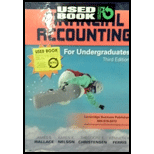
Calculate the missing amount in each column of the financial statements.
Answer to Problem 12BE
Calculate the missing amount in each column of the financial statements as follows:
| Particulars | A | B | C | D |
| Beginning: | ||||
| Assets (16) | 38,000 | $22,000 | 38,000 | 41,000 |
| Liabilities | 28,000 | 15,000 | 29,000 | 19,000 |
| Ending: | ||||
| Assets | 40,000 | 36,000 | 44,000 | 50,000 |
| Liabilities (8) | 22,000 | 28,000 | 20,000 | 24,000 |
| During the year: | ||||
| Sales (4) | 26,000 | 26,000 | 31,000 | 27,000 |
| Expense | 12,000 | 22,000 | 12,000 | 19,000 |
| Dividends (12) | 2,000 | 3,000 | 4,000 | 4,000 |
Table (1)
Explanation of Solution
Financial statements: Financial statements are condensed summary of transactions communicated in the form of reports for the purpose of decision making.
Working note:
- Compute the amount of sales revenue.
Compute the beginning
Compute the ending stockholders’ equity:
Compute the net income:
Compute the amount of sales revenue:
Therefore, the amount of sales revenue is $26,000.
- Compute the amount of ending liability:
Compute the beginning stockholders’ equity:
Compute the amount of net income:
Compute the amount of ending stockholders’ equity:
Compute the ending liabilities:
Therefore, the amount of ending liability is $28,000.
- Calculate the amount of dividends paid or declared during the year:
Compute the beginning stockholders’ equity:
Compute the ending stockholders’ equity:
Compute the amount of net income:
Compute the amount of dividend:
Therefore, the amount of dividend is $4,000.
- Compute the amount of beginning assets.
Compute the ending stockholders’ equity:
Compute the amount of net income:
Compute the amount of beginning stockholders’ equity:
Compute the amount of beginning assets.
Therefore, the amount of beginning assets is $41,000.
Want to see more full solutions like this?
Chapter 1 Solutions
FINANCIAL ACCT.F/UNDERGRADS-W/ACCESS
- I need assistance with this general accounting question using appropriate principles.arrow_forwardCan you provide a detailed solution to this financial accounting problem using proper principles?arrow_forwardPlease provide the answer to this general accounting question with proper steps.arrow_forward

 AccountingAccountingISBN:9781337272094Author:WARREN, Carl S., Reeve, James M., Duchac, Jonathan E.Publisher:Cengage Learning,
AccountingAccountingISBN:9781337272094Author:WARREN, Carl S., Reeve, James M., Duchac, Jonathan E.Publisher:Cengage Learning, Accounting Information SystemsAccountingISBN:9781337619202Author:Hall, James A.Publisher:Cengage Learning,
Accounting Information SystemsAccountingISBN:9781337619202Author:Hall, James A.Publisher:Cengage Learning, Horngren's Cost Accounting: A Managerial Emphasis...AccountingISBN:9780134475585Author:Srikant M. Datar, Madhav V. RajanPublisher:PEARSON
Horngren's Cost Accounting: A Managerial Emphasis...AccountingISBN:9780134475585Author:Srikant M. Datar, Madhav V. RajanPublisher:PEARSON Intermediate AccountingAccountingISBN:9781259722660Author:J. David Spiceland, Mark W. Nelson, Wayne M ThomasPublisher:McGraw-Hill Education
Intermediate AccountingAccountingISBN:9781259722660Author:J. David Spiceland, Mark W. Nelson, Wayne M ThomasPublisher:McGraw-Hill Education Financial and Managerial AccountingAccountingISBN:9781259726705Author:John J Wild, Ken W. Shaw, Barbara Chiappetta Fundamental Accounting PrinciplesPublisher:McGraw-Hill Education
Financial and Managerial AccountingAccountingISBN:9781259726705Author:John J Wild, Ken W. Shaw, Barbara Chiappetta Fundamental Accounting PrinciplesPublisher:McGraw-Hill Education





